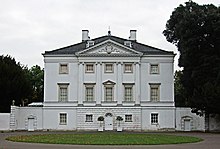Henrietta Howard, Countess of Suffolk
Henrietta Howard | |
|---|---|
Richmond upon Thames | |
| Noble family | Hobart |
| Spouse(s) | Charles Howard, 9th Earl of Suffolk George Berkeley |
| Issue | Henry Howard, 10th Earl of Suffolk |
| Father | Sir Henry Hobart, 4th Baronet |
| Mother | Elizabeth Maynard |
| Occupation | Lady of the Bedchamber to Caroline of Ansbach |
Henrietta Howard (born Henrietta Hobart; 1689 – 26 July 1767) was a British courtier. She is known as the mistress of King George II of Great Britain. She was the sister of John Hobart, 1st Earl of Buckinghamshire.
Biography
Henrietta was one of three daughters of
In 1714, the couple travelled to Hanover, hoping to ingratiate themselves with the future George I of Great Britain. Henrietta met and became mistress to his son, the future George II, and was appointed a Lady of the Bedchamber to his wife, Caroline of Ansbach. In 1723, the now Prince of Wales made a financial settlement with her husband, who was also a member of his household,[2] in exchange for her services as a royal mistress.[3] Queen Caroline liked Henrietta, and was happy that the King kept a mistress she found congenial, although she would occasionally administer snubs to Henrietta in public. Henrietta was noted for her wit and intelligence.
Henrietta and her husband officially separated around 1727, although there was no divorce; that would have required an act of parliament to be passed, with inevitable public scrutiny. Charles succeeded to the Earldom in 1731, allowing Henrietta to describe herself as Countess of Suffolk. Later, after Charles Howard's death in 1733, Henrietta remarried, in 1735, the Hon. George Berkeley, son of the Earl of Berkeley.

After George II moved on to a new mistress,
- I knew a thing that’s most uncommon
- (Envy be silent and attend!)
- I knew a reasonable woman,
- Handsome and witty, yet a friend.
She is generally supposed to be the model for Chloe, a character in Pope's Horatian Epistle To a Lady, and is a character in The Heart of Midlothian by Sir Walter Scott, who describes accurately her ambiguous friendship with Queen Caroline.
See also
- English royal mistress
References
- ^ Tracy Borman, King's Mistress, Queen's Servant: The Life and Times of Henrietta Howard (London: Vintage, 2010), p. 17
- ^ a b Chisholm, Hugh, ed. (1911). . Encyclopædia Britannica. Vol. 26 (11th ed.). Cambridge University Press. p. 27.
- ISBN 0060585447.
- ISBN 978-0-521-36308-2.
Sources
- Henrietta Howard: King's Mistress, Queen's Servant, Tracy Borman (2007)
- Bryant, Julius. London's country house collections (London: Scala Books in association with English Heritage, 1993)
- Bryant, Julius. Mrs Howard: a woman of reason (1688-1767) (London: English Heritage, 1988)
- . Dictionary of National Biography. London: Smith, Elder & Co. 1885–1900.
- John Wilson Croker, ed., Letters to and from Henrietta, countess of Suffolk, and her second husband, the Hon. George Berkeley: from 1712 to 1767, (London: J. Murray), 1824. Online: Vol. 1, Vol. 2.
